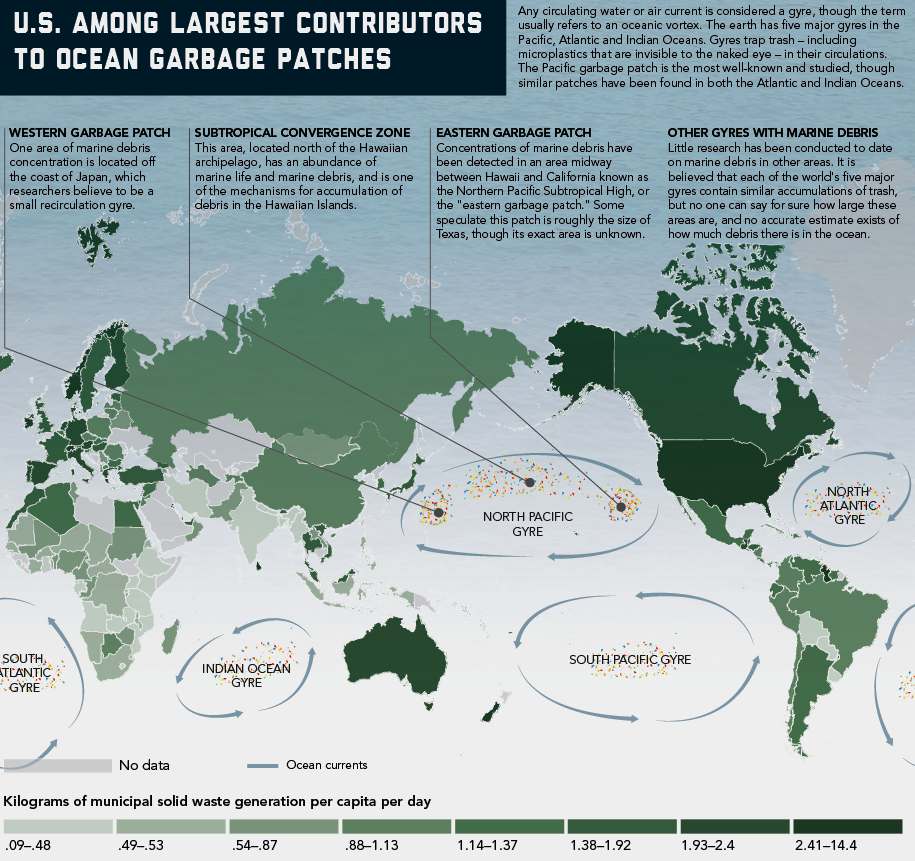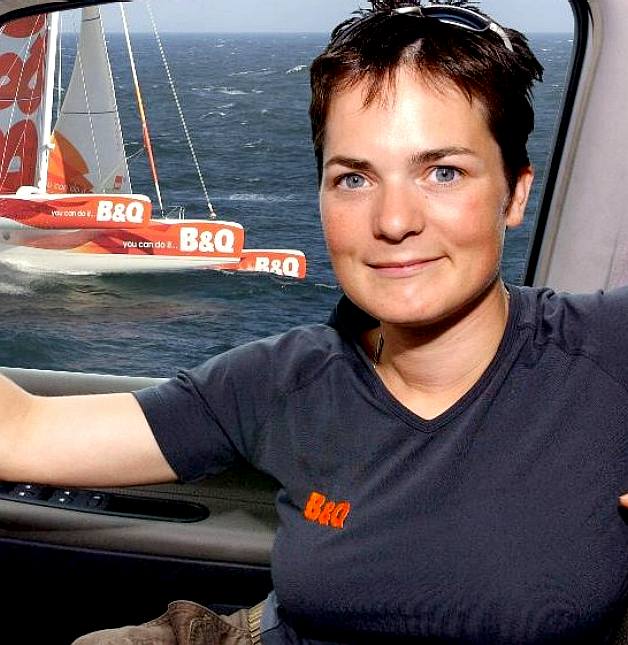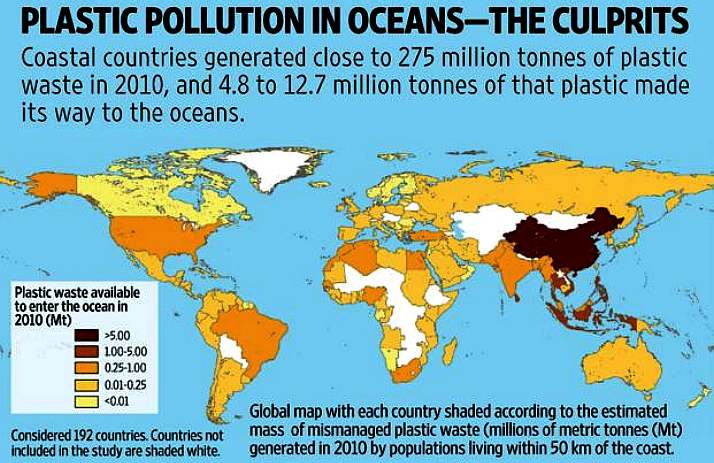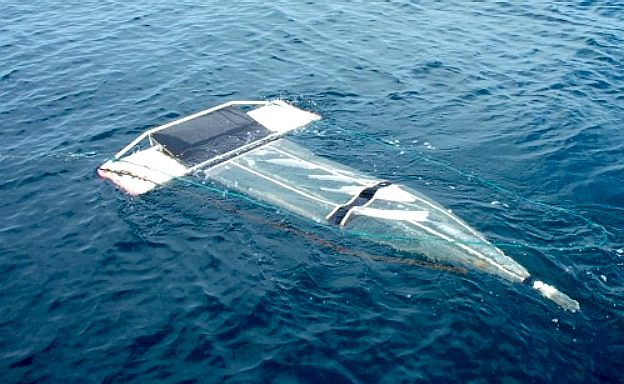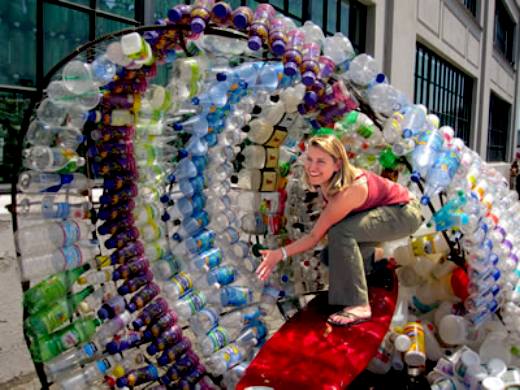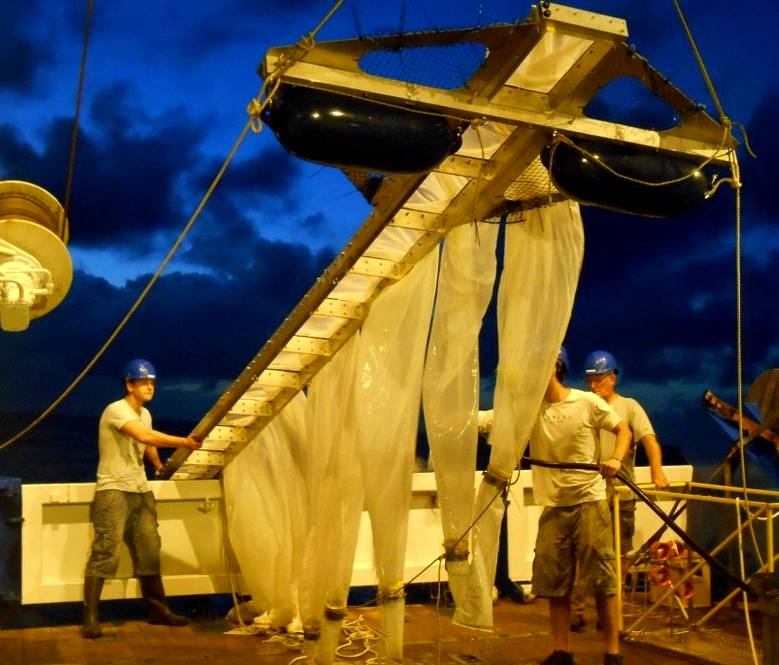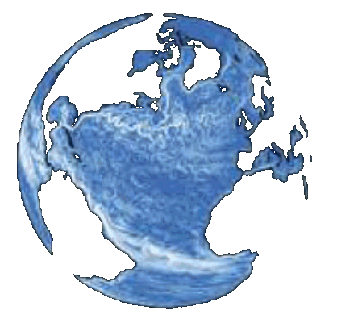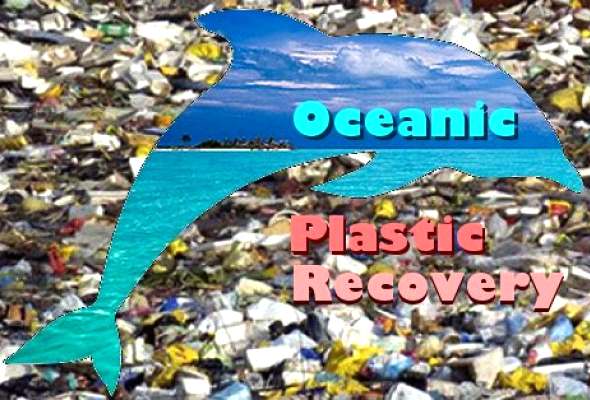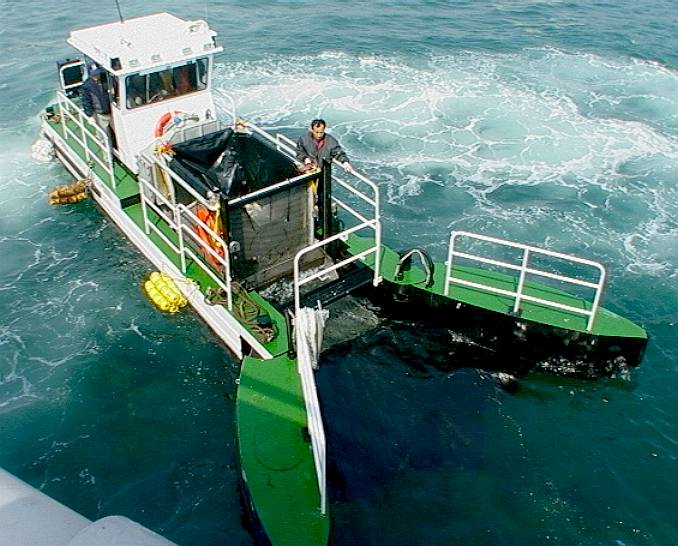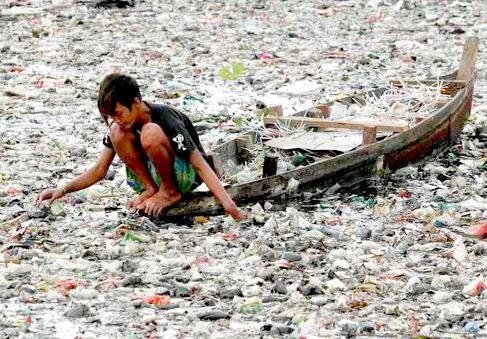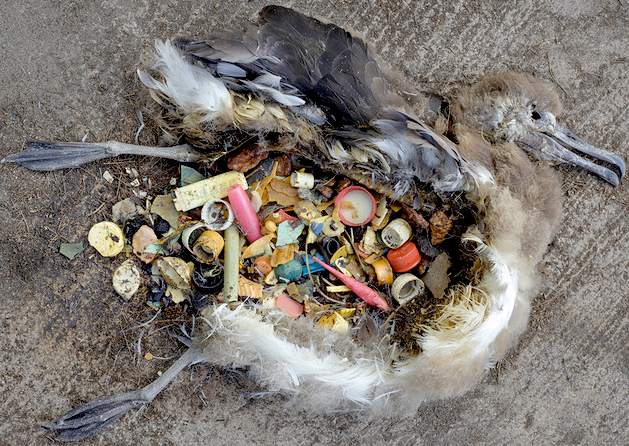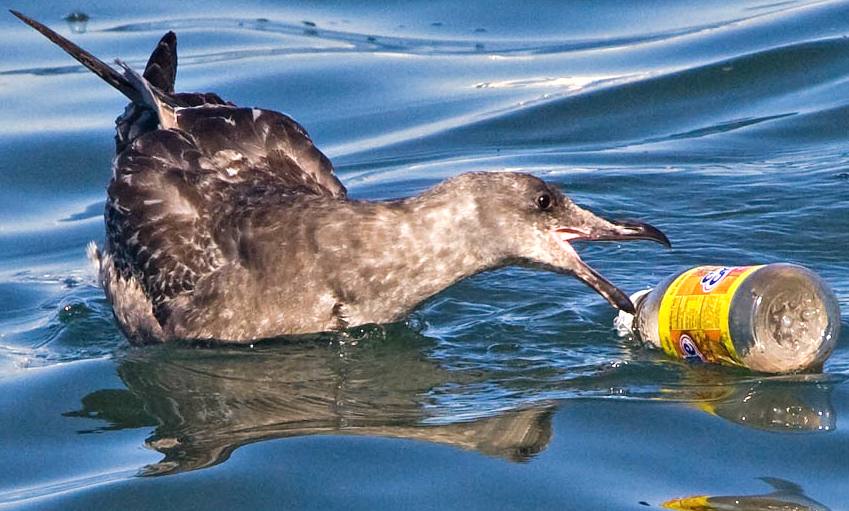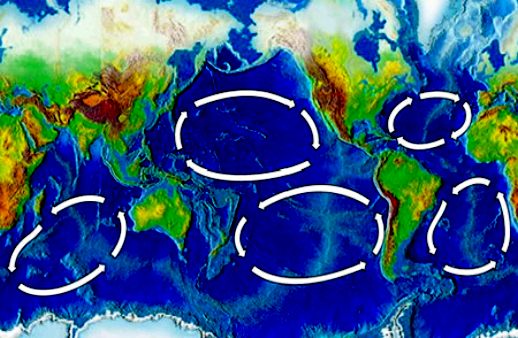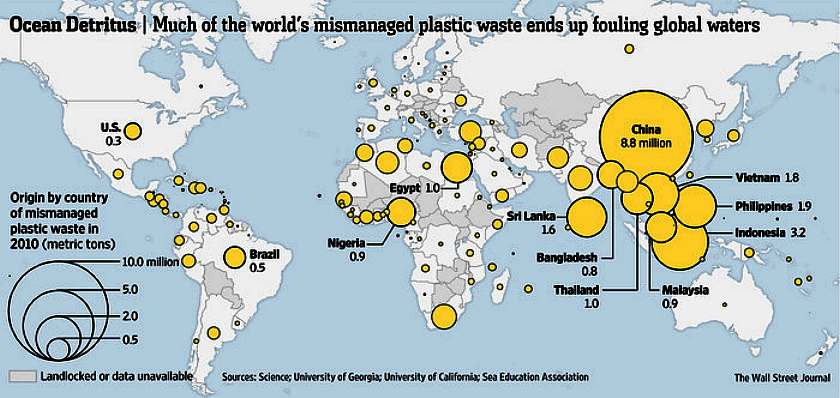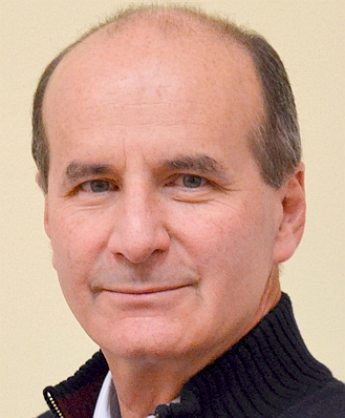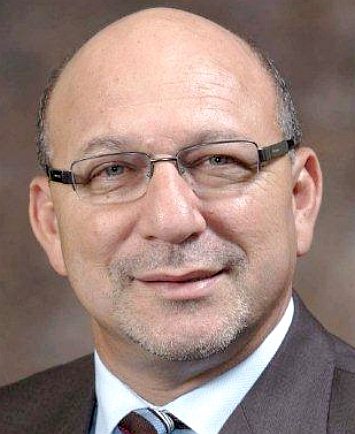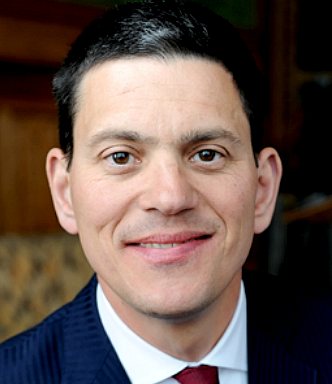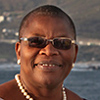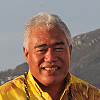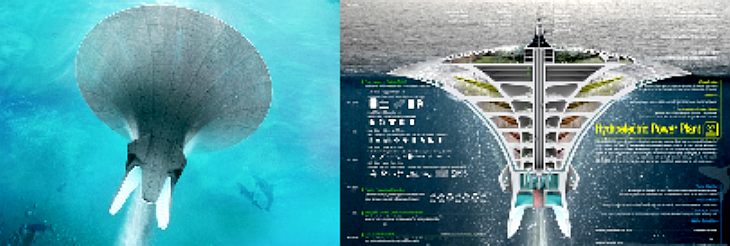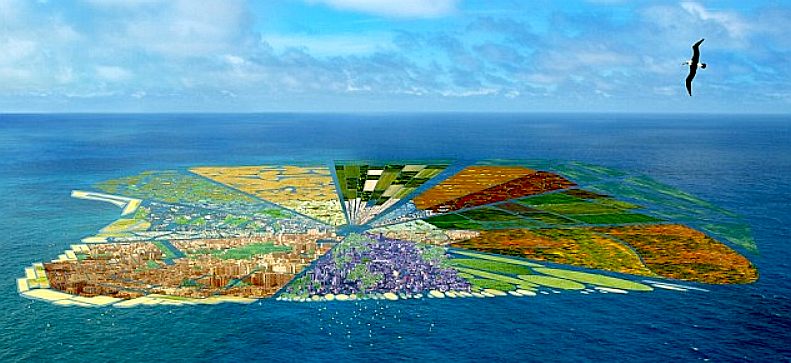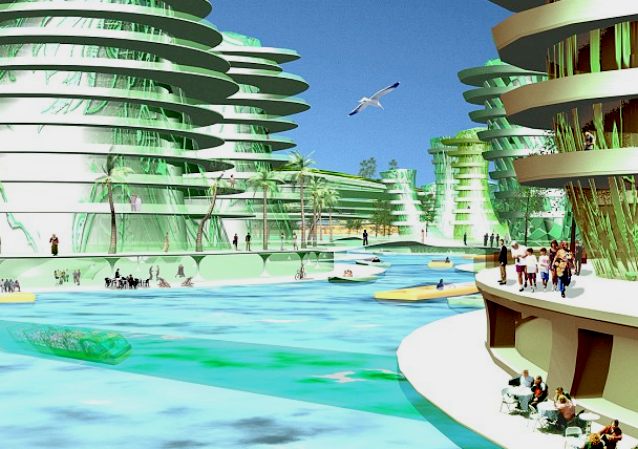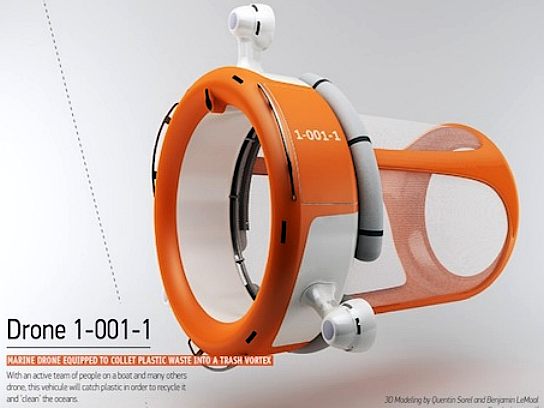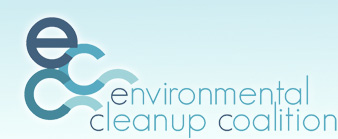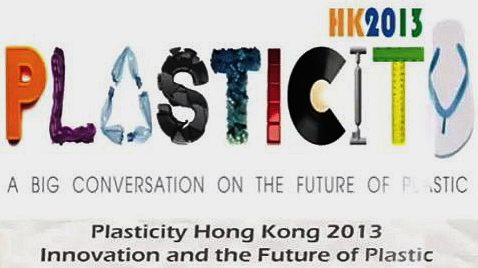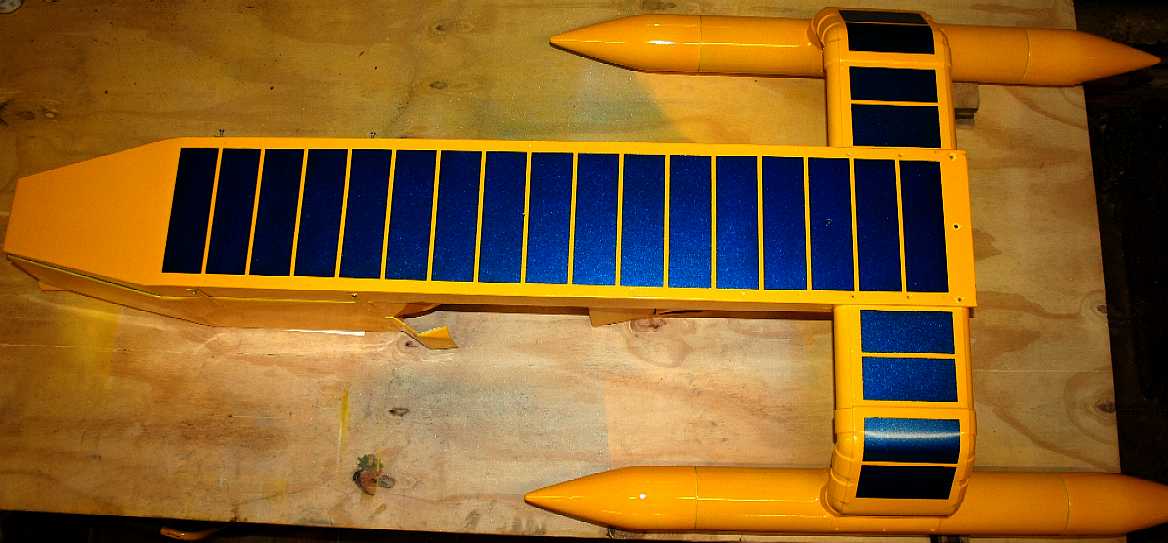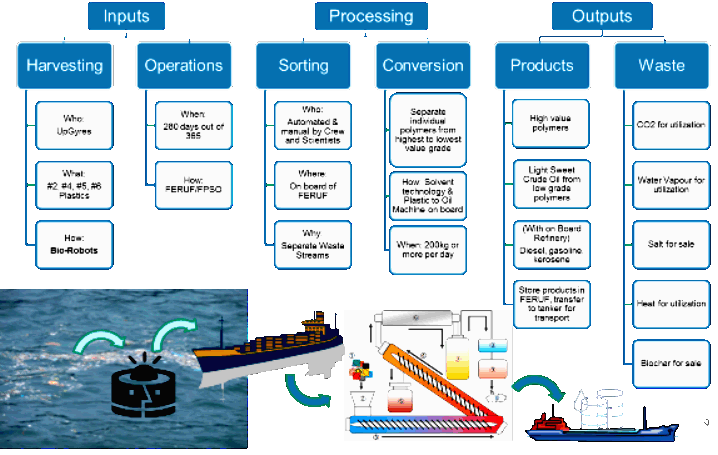|
PLASTIC OCEAN GARBAGE PATCHES
|
||||||||||||||||||||||||||||||||||||||||||||||||||||||||||||||||||||||||||||||||||||||||||||||||||||||||||||||||||||||
|
INTERNATIONAL WASTE MANAGEMENT - This is a superb illustration of the North and South Pacific garbage patches, compared to the North and South Atlantic gyres. The North Pacific gyre is just one of several swirling trash zones (gyres) in our oceans, and it's where a lot of our plastic litter ends up. While these debris patches aren't visible piles of floating trash in the water, they are inverted mountains - a bit like landfill sites at sea - hidden from view. The reality of what they are and how they got there is mind boggling and extremely harmful to marine life. We can't (at the moment) do much about nuclear waste in the oceans (except appeal to reason), but we can act to vacuum up solids before they end up on the ocean floor as a toxic carpet.
We are in a lot of trouble, and very few people in government appear to be serious about trying to put things right. The United Nations has been warning about the problem for many years now. So what is the problem apart from getting finance to the concerns that matter? In a study published in June of 2016 by Eunomia's, Dr Chris Sherrington, the conclusion is that "94% of the plastic that enters the ocean ends up on the sea floor. There is now on average an estimated 70kg of plastic in each square kilometre of sea bed."
The problem is that up until now there has been no culprit to hang to a mast, where it is all of us cumulatively - and some more than others. The other problem is that being in international waters no country feels responsible enough to want to take a stand on plastic pollution. Is it then up to individuals who feel strongly enough about poisoning the oceans, to want to clean them up? It could be, but the technology exists to identify the culprits - and if they do not voluntarily take action to clean their doorsteps, then worst offenders might be prosecuted.
CIRCULAR ECONOMY - [LEFT] Klaus Martin Schwab (born March 30, 1938) is an engineer and economist best known as the founder and executive chairman of the World Economic Forum (WEF). His wife and former secretary, Hilde, co-founded the Schwab Foundation for Social Entrepreneurship. He was born in Ravensburg, Germany. The WEF looks at problems but does not suggest solutions - merely pointing out when there is an issue. [RIGHT] Dame Ellen MacArthur hung up her ocean racing spurs to concentrate on sustainability for the human race. One of her Foundations is working with the World Economic Forum to help others explain to world leaders that there will soon be more plastic in the oceans than fish. The date set for that apocalypse is 2050. If, as they claim, the UN and US are worried about food security, now is surely the time to put some backing on the table. It all begins in the rivers that wash untreated sewage out to sea. Ellen MacArthur teamed up with Leonardo di Caprio to present a united front at the recent Davos event. See our vision for sustainable oceans here.
Fortunately, there are some extremely brave souls who care enough about marine life and planet earth, to have put their thinking caps on, and some of those magnificent thought leaders are featured below, with articles and links to their projects, by way of a review of progress to date. We hope you enjoy reading about the problem and potential solutions, maybe enough to want to contribute to help what amounts to volunteers (non profit making concerns) who are investigating ocean pollution countermeasures. Whatever you decide in terms of financial aid, please give these eco warriors a big hand and mention their hard work to your friends and colleagues, so that more people get to know about our dirty habits.
STUDY IN PLASTIC 2010 - It is fair to assume that some countries are unlikely to produce waste that would end up in the oceans in great quantities. The above world map shows us, at a glance, who is producing serious concentrations of waste. These are the culprits that international law enforcement agencies should target. A first stage of such operations would be to educate the governments responsible, with a recommendation that they in turn educate their manufacturers and then end users. If that has little effect, then prosecution with heavy fines is likely to bring up short, those who refuse to deal with their waste responsibly. Education is likely to reduce the time it would take for a fleet of SeaVax machines to clean up the oceans - to restore a circular ocean economy. Asia and the Americas are clearly the most polluting geographical regions.
There are 5 swirling ocean garbage patches called gyres. The largest gyre is the Great Pacific Garbage Patch, located between Hawaii and California, held to be about the size of France at the moment.
RECYCLING & GLOBAL WASTE
SO, WHAT IS A GYRE?
In oceanography a gyre is any large system of rotating ocean currents, particularly those involved with large wind movements. Gyres are caused by the Coriolis Effect; planetary vorticity along with horizontal and vertical friction, which determine the circulation patterns from the wind curl (torque). The term gyre can be used to refer to any type of vortex in the air or the sea, even one that is man-made, but it is most commonly used in oceanography to refer to the major ocean systems.
Try it for your self, put some water in a basin with some plastic beads, or something else that floats. Stir the water round and round, and you will find an accumulation in the centre. This will not work as well as in the oceans, because of attraction to the sides. There are no sides in the ocean, save beaches.
Manta Trawls are used by Scientists to collect zooplankton samples and are being used to collect plastic samples. (For more information about the Manta Trawl: http://5gyres.org/global_research) It is possible to create a Modified Manta Trawl to retrieve smaller plastic bits in large quantity from the ocean and protect marine life by using a filter/screen at the entrance.
WHAT ARE GARBAGE PATCHES?
Ocean gyres circle large areas of stationary, calm
water, into which debris drifts, and due to the region’s lack of movement, can accumulate for years. These regions are called garbage patches. The Indian Ocean, North Atlantic Ocean, and
North Pacific Ocean all have significant garbage patches. The garbage patch in the North Pacific Ocean is sometimes called the Pacific trash vortex or the
Great Pacific Garbage
Patch.
it is the largest of the big five plastic dumps.
Not far off from reality, Kathleen Egan gives us her vision of a future where plastic in our oceans remains untreated. We will all be surfing in the stuff.
HEALTH EFFECTS
Toxic chemicals (including PCBs and DDTs) are adsorbed by the plastic, increasing the concentration a million times (Mato et al., 2001). After entering the food chain, these persistent organic pollutants bio-accumulate in the food chain (Tanaka et al., 2013). Health effects linked to these chemicals are: cancer, malformation and impaired reproductive ability (Takada, oceanhealthindex.org). All in all, it's a cocktail that we could do without.
WHO MAKES ALL THIS PLASTIC?
Plastic comes from oil after chemical refining and oil comes from petroleum companies. The companies producing the most polymers and polyolefins, or plastic products derived from such oil derivates are:
They feed thousands more companies who in turn provide drinks bottles and other packaging to shops and supermarkets where you buy products and finally dispose of the single use plastic. This would not be a problem if there was an ocean safety net, but there is not as yet. Hence, we need to lobby politicians to make the money available for effective recycling on land and from the sea.
DEPTH OF PLASTIC POLLUTION IN OCEANS REVEALED Thursday 26 February 2015
Wind and waves can mix buoyant ocean plastics throughout the water column, but most of their mass remains at the sea surface, according to research led by The University of Western Australia.
PhD candidate Julia Reisser and her international team published the study in the journal Biogeosciences, reporting the first ever high - resolution vertical profiles of plastic pollution in the so - called “ocean garbage patches”.
Most of the submerged plastics were very small – less than 1 mm across. Previous studies noticed that tiny plastics were missing from the oceans. Ms Reisser is quoted as saying: “We have shown that at least a fraction of this missing plastic is still adrift at sea, but at depths greater than the surface layer that is usually sampled by scientists.”
When the wind was stronger than 10 knots, more than half of the 0.5-1mm particles were underwater. But even when there was no wind, about 20 per cent of these little plastics were still below the surface.
By using a new measuring device called a Multi-level Trawl, the researchers were able to measure plastic concentrations in ten layers simultaneously, down to a depth of 5 meters.
While taking measurements in the North Atlantic Garbage Patch, the team demonstrated that the mass concentration of millimeter-sized plastics drops exponentially from the sea surface to deeper waters.
The pioneering survey was conducted aboard the SV Sea Dragon, owned by Pangaea Exploration. It was sponsored by The University of Western Australia and the Ocean Cleanup Foundation.
Founder of the Ocean Cleanup Foundation and co-author of the study, Boyan Slat is quoted as saying: "The results of the study are good news to those developing technologies to extract plastic from oceanic garbage patches. Almost all plastic was on or very close to the surface, meaning it’s within reachable distances for a cleanup operation.”
ABSTRACT
- RESEARCH ARTICLE
"Millimetre-sized plastics are numerically abundant and widespread across
the world's ocean surface. These buoyant macroscopic particles can be mixed within
the upper water column by turbulent transport. Models indicate that the largest
decrease in their concentration occurs within the first few metres of water, where
Our results show that plastic concentrations drop exponentially with water depth, and decay rates decrease with increasing Beaufort number. Furthermore, smaller pieces presented lower rise velocities and were more susceptible to vertical transport. This resulted in higher depth decays of plastic mass concentration (milligrams m−3) than numerical concentration (pieces m−3). Further multi-level sampling of plastics will improve our ability to predict at-sea plastic load, size distribution, drifting pattern, and impact on marine species and habitats."
AUTHORS
1.
School of Civil, Environmental and Mining Engineering and UWA Oceans Institute,
University of Western Australia, Perth, Australia 2.
The Ocean Cleanup Foundation, Delft, the Netherlands 3.
Roger Williams University, Bristol, USA 4.
Pangaea Exploration, Miami, USA 5.
Instituto de Oceanografia, Universidade Federal do Rio Grande, Rio Grande,
Brazil 6.
Centre for Microscopy, Characterisation and Analysis, University of Western
Australia, Perth, Australia
Ms Reisser received an International Postgraduate Research Scholarship and a UWA
Completion Scholarship.
Julia Reisser
- UWA Oceans Institute - jureisser@gmail.com
COMPUTER GLOBAL OCEAN CURRENT SIMULATION - Dr Katya Popova, an ocean modeller at the NOC held workshops at the Ocean Business event in April 2015. She showed how the latest advances in ocean circulation computer modelling are providing increased detail for environmental consultants – including how new sea routes could appear in the Arctic in the future and how plastic and oil ocean waste distribution might be predicted. This could be an invaluable tool for projects like the SeaVax ocean cleaning robots if allied to the proposed SeaNet fleet operations. At the time of writing SeaVax is a 'proof of concept' model, with the team now looking to design and build a full size prototype.
HOW
FAR HAS IT SPREAD ? THE GUARDIAN
DEC 2014 - ANTARCTICA, AKADEMIK SHOKALSYIY
Expedition
Chris Turney is quoted as saying: “Once we got back home and made sure everyone was all right, we got on with working up the data and getting a whole load of papers ready for
submission.” Like the rescue mission, this involved plenty of waiting.
“It took nearly six months to get all the samples through quarantine.”
GRIST TO THE MILL - The Oceanic Plastic Recovery project is based on technology that is viable and proposed in a manner that should work. The suggestion is to use solar powered robot barges to truck plastic waste from the five ocean gyres to a land station for processing. We believe this to be one of the most promising solutions and well worth supporting.
ENVIRONMENTAL CLEANUP COALITION
The Environmental CleanUp Coalition are are seeking funding for an Ocean Gyre Cleanup Contest and prototype development of the best concept.
HEADQUARTERS
ADDRESS:
10507 East Zayante Road, Email: Rich@GyreCleanup.org
Rich Sundance Owen - Executive Director
Diane Rigoli - Website Project Manager
Andy Maeding - Educational Programs Director
Alexi Sanders - Editor
Looking somewhat like a green lobster, this boat funnels waste into a hopper. As you can see the vessel is manned and the hopper is rather small for our liking. But it is a start. It looks a lot like the proposed Dyson river cleaning barge, or is that the other way around.
POTENTIAL SOLUTIONS & USES
Once
plastic has been harvested from the ocean, these are just 3 of the
suggested sustainable solutions as to what to do with it.
CONCEPTUAL PROJECTS
Philippines - A lad is looking for items to recycle
What's
for lunch mum? The Eastern Garbage Patch is a large gyre of marine debris located near the Midway Islands in the Pacific Ocean.
Albatrosses in the area give birth to 500,000 chicks every year, and nearly half of them
die – many of them after consuming plastic fed to them by their parents, who think it’s food.
Plastic waste has a huge detrimental affect on wildlife. Plastic debris causes the deaths of more than a million seabirds every year, as well as more than 100,000 marine mammals. Syringes, cigarette lighters and toothbrushes have been found inside the stomachs of dead seabirds, which mistake them for food. Midway Atoll receives substantial amounts of marine debris from the Great Pacific Garbage Patch. Of the 1.5 million Laysan Albatrosses that inhabit Midway, nearly all are found to have plastic in their digestive system.
OTHER WATER CLEAN UP RESEARCH PROJECTS IN THE UK 2014/2015
Innovate UK and the Engineering and Physical Sciences Research Council (EPSRC) are to invest up to £4.5m in collaborative R&D projects that seek to increase the recovery of valuable materials from waste streams.
The five main ocean 'Gyres' have become plastic garbage patches. Does that make you proud to be a human? Not us, we feel ashamed that this is the legacy that we are forcing on wildlife, as we enjoy the spoils of an unsustainable society.
RECYCLING & GLOBAL WASTE
The global
waste and recycling market is currently worth around $1tr. The waste sector in the UK was valued at over £12bn in 2011, with an annual growth rate of between 3% and
4%, and that means more plastic garbage for our oceans.
PLASTIC WASTE PRODUCERS 2010 - This map of the world illustrates plastic waste producers in relation to poor management - hence, the likelihood of pollution of international waters. It is a useful visualization, telling us where to begin cleaning up for maximum results globally. The problem with this approach may be that the biggest polluters may not want to tackle their problem patch, relying on the efforts of other countries to do their dirty work for them. In theory, the culprit sovereign state could be prosecuted for allowing their manufacturers to mismanage waste to this degree. How about it chaps. It's no rocket science. You need to set a case precedent, to create an example of what will follow if a more responsible attitude is not adopted. Money talks!
THE GLOBAL OCEAN COMMISSION - CO-CHAIRS
THE GLOBAL OCEAN COMMISSIONERS
LOBBY YOUR OCEAN REPRESENTATIVE - These are the people to write to with your complaints and where appropriate; evidence. The Global Ocean Commissioners are a group of exceptionally well qualified persons with the experience needed to be able to formulate a plan that might work to reverse the present degradation of our oceans. The GOCs will not just deal with ocean pollution, but will also seek to regulate fishing to assist in fish stock recovery. We hope they will be able to make a difference. They are supported by Pope Francis, President Obama, Ban Ki-moon and even Leonardo di Caprio. There are 17 members of the GOC, divided as 12 men and 5 women. So far they have elected to do nothing about the mounting mountain of plastic in our seas.
RECYCLING & GLOBAL WASTE
PLASTIC OCEANS FOUNDATION
The Plastic Oceans Foundation is a registered United Kingdom Charity (Number 1139843). We are dedicated to protecting and improving the environment. Through a wide range of activities the Foundation will educate, provide a resource base for study and research, campaign for improvements in legislation and policy, raise funds for the development of solutions and develop a worldwide integrated social media network aimed at achieving the mission.
SEAWER
SKYSCRAPER - The Seawer is a self-supported hydroelectric power station that can generate electricity using seawater at the same time that it cleans up plastic waste. The huge structure separates plastic particles and fluids, recycles seawater and releases it back into the ocean.
The structure receives energy from the sun, ocean and plastics and moves slowly from one polluted area to the next. The project received an honorable mention in the 2014 eVolo Skyscraper.
DAILY
MAIL SERIOUS OR SPOOF ? - An island the size of Hawaii made entirely from plastic bottles could become the hottest postcode on earth, and is part of an incredible environmental vision for the future.
PLASTIC POLLUTION FACTS
1. In the Los Angeles area, 10 metric tons of plastic
are carried into the Pacific Ocean every day.
A 3D model of the Drone 1-001-1 from Elie Ahovi. The Drone 1-001-1 concept features a steel body construction with composite materials for strength and lightweight operation. Its battery-powered motors are quiet and efficient. Ahovi estimates the drone could remain submerged for about two weeks before needing a charge. The ocean drone concept uses an infrasound system to help it navigate away from schools of fish and larger underwater objects. The submarine would need to be launched and recovered by human operators of a medium sized ship. We think that this will raise the cost of plastic recovery to unacceptable levels. A better system would be for a complete process that needs no crew.
ACIDIFICATION - ADRIATIC - ARCTIC - ATLANTIC - BALTIC - BAY BENGAL - BERING - CARIBBEAN - CORAL - EAST CHINA ENGLISH CH - GOC - GULF GUINEA - GULF MEXICO - INDIAN - IOC - IRC - MEDITERRANEAN - NORTH SEA - PACIFIC - PERSIAN GULF - SEA JAPAN STH
CHINA - PLASTIC
- PLANKTON - PLASTIC
OCEANS - SEA
LEVEL RISE - UNCLOS
- UNEP
WOC
- WWF AMAZON - BURIGANGA - CITARUM - CONGO - CUYAHOGA - GANGES - IRTYSH - JORDAN - LENA - MANTANZA-RIACHUELO MARILAO
- MEKONG - MISSISSIPPI - NIGER - NILE - PARANA - PASIG - SARNO - THAMES
- YANGTZE - YAMUNA - YELLOW
LINKS & REFERENCE
There's
More Than One Ocean Trash Gyre! 5 Gyres Project Switches... treehugger.com›clean…ocean-trash-gyre-5…video.html
5
Gyres of Plastic Trash Pollutes the World's Oceans » EcoWatch ecowatch.com›2014/04/21/5-gyres…trash…oceans/
Plastic
pollution accumulates in oceanic gyres 5gyres.org›see_global_research/
socialphy.com›posts/off-topic/14979/5-Gyres.html
Garbage
Patch Primer: What's an Ocean Gyre? : Discovery News news.discovery.com›earth/oceans…patch…ocean-gyre…
Ocean
junk is largely concentrated in five ocean gyres cbc.ca›news/technology…mh370…ocean-trash-1.2594539
5
Gyres: Plastic in the World’s Oceans electrolux.pl›sv/Innovation/Campaigns/Vac…5-Gyres/
lefitness.com.br›erro/trash-gyre-ocean
Gyres
Definition. Crossword Dictionary. | ocean basin
model png
klettertechnik-bauservice.de›2/gyres-of-trash
HONG KONG - As of 2013, 40% of the world’s ocean surfaces were covered with some form of floating plastic trash. The statistics are sobering, but a growing number of companies and organizations including Ocean Recovery Alliance are eyeing solutions to the burgeoning plastic waste issue. Innovative solutions to manage plastic waste, both pre and post consumption will specially be showcased on June 6th at Plasticity Hong Kong, in a big discussion on plastic and innovation in this sector.
This conference
was to fuel a re-imagining of the future of plastics through a program of keynotes, case studies, and panel discussions, where many leading players of the “plastics puzzle” are brought together under one roof. Attendees of the forum
came from wide-ranging sectors, including textiles, retailers, manufacturers, recyclers, design and packaging, waste-to-fuel companies, bio-plastic producers and government policy makers.
Inhabitat 19 year old student develops cleanup array to remove 7250000 tons plastic-from worlds oceans The mind unleashed author Tmuorg Plastic
Boards 5 Gyres - Understanding Plastic Marine Pollution Wind Driven Surface Currents: Gyres SIO 210: Introduction to Physical Oceanography - Global circulation SIO 210: Introduction to Physical Oceanography - Wind-forced circulation notes SIO 210: Introduction to Physical Oceanography - Lecture 6 Physical Geography - Surface and Subsurface Ocean Currents North Pacific Gyre Oscillation — Georgia Institute of Technology Education National Geographic ocean gyre National Geographic 2014 July ocean-plastic-debris-trash-pacific-garbage-patch Plastic Soup News Blogspot 2014_July Un package me.whats wrong with plastic Neuro research project 2013 death-by-plastic Indiegogo projects sailing the Atlantic ocean to study plastic pollution http://ecowatch.com/2014/04/07/22-facts-plastic-pollution-10-things-can-do-about-it/ Biogeosciences Net report on ocean plastic 2015 http://www.eunomia.co.uk/reports-tools/plastics-in-the-marine-environment/ http://www.uwa.edu.au/ http://www.dailymail.co.uk/news/article-1290525/Plastic-paradise-Scientists-plan-turn-Pacific-Ocean-waste-floating-island.html http://www.biogeosciences.net/12/1249/2015/bg-12-1249-2015.html http://www.traveldailynews.asia/news/article/52369/plasticity-2013-hong-kong-serves http://ecowatch.com/2014/04/07/22-facts-plastic-pollution-10-things-can-do-about-it/ http://www.lastnightsgarbage.com/?cat=56 https://www.indiegogo.com/projects/sailing-the-atlantic-ocean-to-study-plastic-pollution http://unpackageme.com/whats-wrong-with-plastic/ http://neuroresearchproject.com/2013/02/21/death-by-plastic/ http://www.worldwildlife.org/threats/pollution http://plasticsoupnews.blogspot.co.uk/2014_07_01_archive.html http://en.wikipedia.org/wiki/Marine_debris http://www.plasticoceans.net/the-foundation/ http://www.greatrecovery.org.uk/plastic-its-a-lovehate-thing/ http://www.greatrecovery.org.uk/ http://www.epsrc.ac.uk/ http://themindunleashed.org/author/tmuorg http://seaplexscience.com/ http://abundantseas.org/ http://www.gyrecleanup.org/cleanup-plan/ http://education.nationalgeographic.co.uk/education/encyclopedia/ocean-gyre/?ar_a=1 http://www.plasticboards.com
PROOF OF CONCEPT - The above vessel is a significantly modified version of the Bluefish ZCC concept, adapted to clean garbage from the world's ocean gyres. The SeaVax is a robotic ocean workhorse that is based on a stable trimaran configuration. This design uses no diesel fuel to cruise the oceans autonomously (COLREGS compliant) 24/7 and 365 days a year as required. With such awesome power generating capability, a SeaVax ZCC can extract plastic waste from deep sea ocean garbage patches. Several of these cleaners operating as Atlantic, Indian and Pacific ocean fleets could make such conservation measures cost effective, and even potentially attractive to governments around the world - for the health of the world. Recovered plastic could be processed to produce oil, energy or recycled products. Better than letting fish and seabirds eat the waste and kill themselves, and who knows how that may affect us, where seafood is an essential resource for mankind. You can help Bluebird Marine Systems take this design to a full size pre-production prototype by donating whatever you can afford when we are ready to accept crowd funding contributions. Thanks for reading this and please spread the news.
FACTORY SHIP PROPOSAL - The above diagram rather nicely illustrates a logical sequence for harvesting ocean plastic, transferring to a floating factory and (presumably) transporting the resulting products to end users. It is unfortunate that a ship such as this would not be capable of harvesting sufficient plastic to warrant operation at sea. The only realistic way is to increase the harvesting capacity using dedicated machines, and then to feed that harvest to a factory ship, or ships.
|
||||||||||||||||||||||||||||||||||||||||||||||||||||||||||||||||||||||||||||||||||||||||||||||||||||||||||||||||||||||
|
This
website is Copyright © 2018 Bluebird Marine Systems Limited.
The names Bluebird™, Bluefish™,
Miss Ocean™, RiverVax™,
SeaNet™,
SeaVax™
and the blue bird in flight
|
